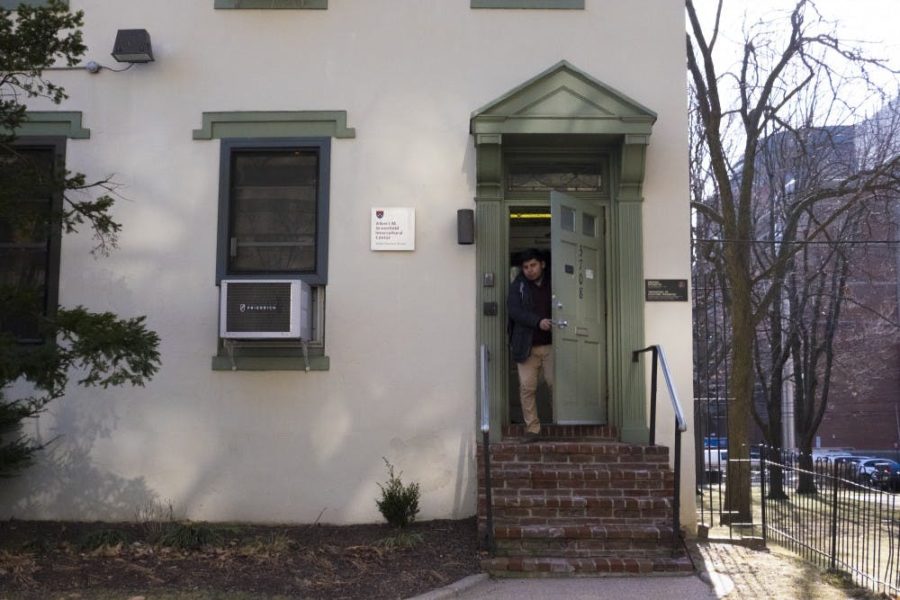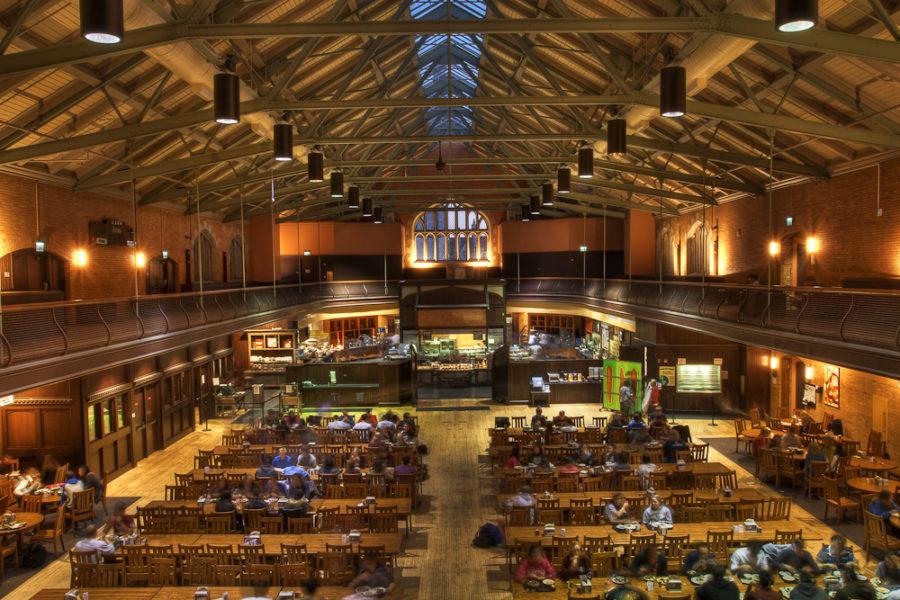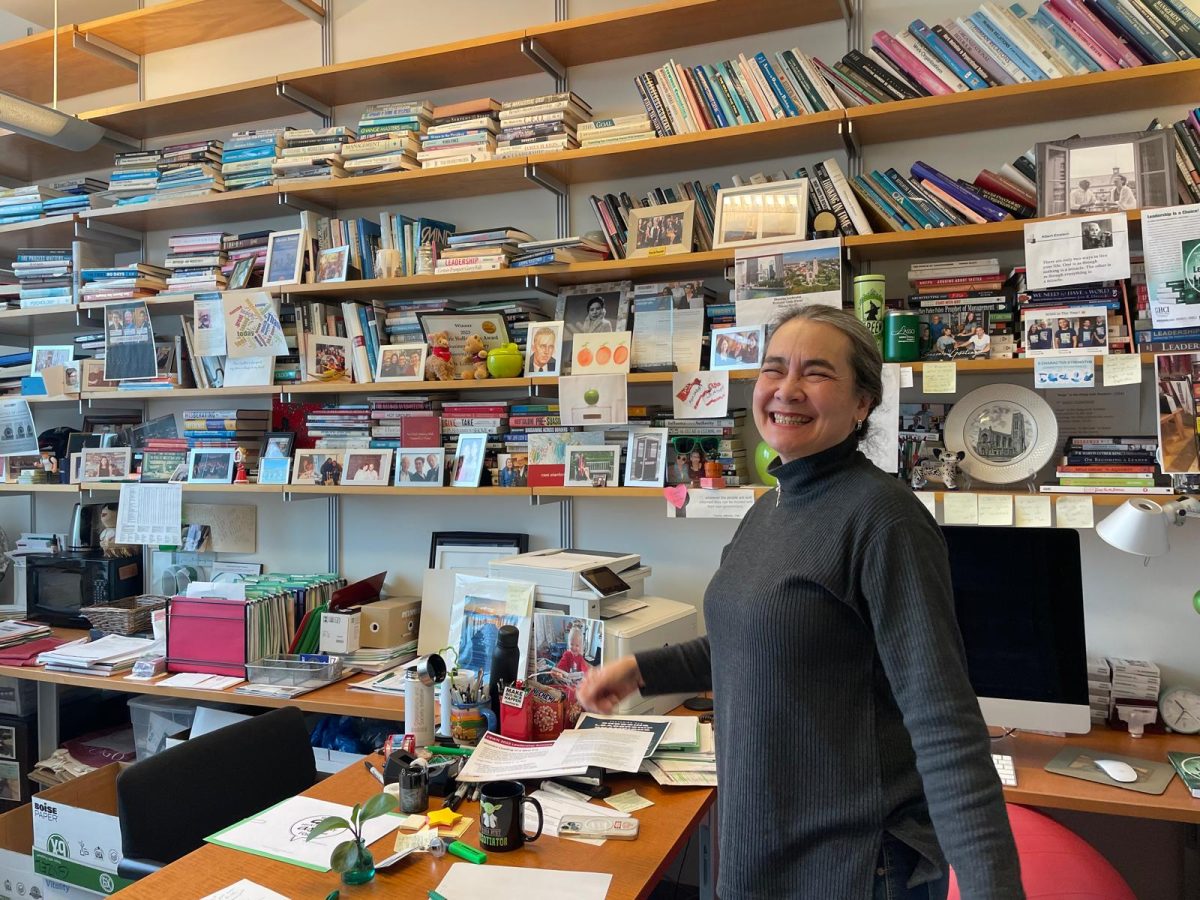Student activists have been pushing for cultural centers—buildings designated for students of a particular racial or ethnic minority, like a Black House or a Pan-Asian House—for more than four years. A new quantitative study by a UChicago professor argues that these centers, or “counterspaces,” would benefit nonwhite students’ mental health and could improve lagging graduation outcomes for minority students.
Last month, comparative human development professor Micere Keels published Campus Counterspaces: Black and Latinx Students’ Search for Community at Historically White Universities. The book examines how racial-ethnic identity shapes the experiences of Black and Latinx students at predominantly white institutions — institutions which were not always open to students of color.
One study by Keels found that “strategic disintegration,” or periodic separation of non-white students from a majority-white campus, benefits the mental and emotional experiences of students of color.
The study tracked over 500 students from historically marginalized backgrounds—that is, Black, Latinx, mixed-race, or indigenous heritage—throughout their time enrolled at five historically white institutions in Illinois, and found that those with access to “counterspaces,” or places reserved for nonwhite students, where their racial or ethnic background do not make them stand out, had more positive college experiences and were more likely to graduate within six years.
Right now, Keels told The Maroon, there is a disparity in outcomes for students of color and white students once enrolled. Keels said that one of the roots of this inequality is the way students of color at historically white institutions are vulnerable to feelings of isolation, disillusionment, or lack of connection to their schools. She sees cultural centers, which have programming built around and inspired by the backgrounds of students of color and offer them space in which they are not minorities, as a way to improve mental health and graduation rates for students of color.
Although the University of Chicago has an extremely high graduation rate overall, Black and Latinx students have a six-year graduation rate of 88 percent, lower than the rate for white students, 94.7 percent.
“Even though the graduation rate for all students is high here, you still see these racial and ethnic and income gaps in graduations. But if you look across the country, less than half of Black students and I think just over half of Latinx students that enroll at college graduate,” Keels told The Maroon.
Michelle Yang is a fourth-year who organizes with UC United, “a coalition of multicultural student organizations formed to make the University of Chicago campus more inclusive” for students of color. She said that, while talking with friends one day, she realized that the majority of her friends and acquaintances who had taken a leave of absence or left school were people of color.
“We’re like, people we knew took a bunch of leaves, but we’re thinking about it and those are mostly people of color. We don’t have statistics, but because I’m friends with certain people and we come together, we realize our experiences aren’t individual,” Yang said.
Yang believes that many nonwhite students take leaves of absence due to a sense that “the University…right now isn’t a place for students of color.”
The movement is a priority for top student leaders. Fourth-year Kosi Achife, Vice President for Student Affairs, has been a vocal advocate for cultural centers, having been involved in the initiative since her first year.
“I think there’s an underbelly of campus of people who take leaves of absence, for a quarter or for a year, who have to take a 13th quarter, who have had to drop out of school altogether,” Achife told The Maroon, “and they’re disproportionately low-income, queer, and people of color.”
Yang, Achife, and Keels all see cultural centers as a solution to the graduation disparity and anecdotal proliferation of leaves of absences among students of color, along with functioning as places where these students are less likely to encounter racial or ethnic bias than they would be in a majority-white community.
Cultural centers, a central demand of UC United since the organization was founded in spring 2017, are physical spaces intended for minority students to gather, conduct programming, and decompress. The spaces would be independent of the Office of Multicultural Affairs, whose mission is to “foster a campus environment that supports the exploration of varied identities and their intersections” and currently offers orientation events, mixers for graduate and professional students of color, and a speaker series addressing issues of race and ethnicity.
Olga Guerrero, a third-year organizer with UC United, said the organization wants different spaces within these cultural centers to address different subsets of larger racial and ethnic categories. For example, a Black House might have an Afro-Caribbean room, or a room in the Pan-Asian house could be dedicated specifically to Vietnamese-Americans.
UC United organizers emphasized that cultural centers would not be out-of-bounds for people who are not of the designated racial or ethnic minority.
To exclude non-Black or non-Latinx students, Achife said, would be “reproducing the standards of exclusion that the University runs on with some of its buildings and programs. We want it to be open to the community.”
A cultural center, Guerrero said, “would be a space for us to have different kinds of programming for each center, teach-ins, or, say, programming that speaks to Afro-Latinx identities to bring more awareness to the fact that a lot of the time Afro-Latinx [people] are erased because they don’t tend to think of Black people as Latinx,” Guerrero said.
Guerrero said that she could not give concrete details about specific houses, like a Black House or a Pan-Asian House, because the “vision for each one is really planned out by the different cultural organizations that are part of UC United. I can’t speak to specific features that, say, OBS [Organization of Black Students] would want to see, for example,” she said.
Guerrero said that UC United sees cultural centers as spaces to showcase heritage from places that are less well-represented in the Core curriculum, which Keels identified as a source of potential isolation for students of color.
“If you don’t see yourself in the institution, in the artifacts of the institution, in the faculty that are there, in the texts that you read, it can be experienced as isolating and culturally disaffirming, because everything says these are the valued thinkers and bodies of knowledge and none of them look like you or represent your cultural tradition,” Keels said. Guerrero told The Maroon that UC United wants to stock cultural centers with art and literature representing those cultural traditions.
“One of the most important things we picture is a library in each of the cultural centers that includes more literature on our different cultures, the histories of our different cultures, more books that fall more under ethnic studies,” Guerrero said.
Addressing mental health, Guerrero said that UC United hopes the University would hire therapists for each of the cultural centers who are specifically trained in cultural competency and issues pertaining to students from non-white, non-upper-class backgrounds.
“The idea behind that is that it makes it easier for students to go to their cultural center and immediately find someone there that they could meet with and talk to,” she said.
Guerrero said that UC United envisions the cultural centers as home bases for different racial and ethnic communities on campus, in both a logistical sense and as gathering spaces.
“The idea behind cultural centers is to have these physical spaces that become the nexus of all the resources we want easier access to, so we don’t have to be running around the University—it would be a lot easier for us to go to this one specific center for easier access to resources,” Guerrero said.
Achife added academic and professional resources tailored to students of color to the list of needs UC United hopes to address through cultural centers.
“We can have tutors that won’t demean the intelligence of students of color,” Achife said. “We can have career advancement being able to meet students where they’re at, because we don’t all come from parents who were lawyers or politicians.”
Not everybody sees cultural centers as an unequivocal good. Fourth-year Ezra Max said he is skeptical that university-run Cultural Centers are the solution to problems around bias and isolation.
“I recognize that the ambient culture of college campuses is reflective of the sensibilities of upper class white men,” Max said. “I know there are serious people doing serious thinking around these issues, and I don’t want to knock that.” But he argued that the high cost of the initiative could be counterproductive.
“Tuitions are high precisely because of these sorts of expensive bureaucratic initiatives, and high tuitions can make campus less diverse,” he said. If the University decides to establish cultural centers, Max said, “They will be another university apparatus which requires far, far more rigorous justification to reorganize or remove than it ever did to implement.”
Another second-year student, who asked not to be named, had serious reservations about Cultural Centers as a solution to improving representation and programming for historically marginalized students.
“I’m not completely against cultural centers, but I do think they have problems when it comes to expressing certain cultures accurately,” she said. “Sometimes they’re created by people that aren’t actually associated with the culture and are just trying to make up for past misdeeds so they may not even highlight the culture of a particular group and may just emphasize the history of that group with the people who made the center.”
She also worried that after the publicity value of these centers wore off, they would be neglected or become inaccurate representations of the group for which the facility was allocated.
“A lot of times centers aren’t properly maintained either and are in odd or cheap locations because they don’t generate revenue so they may get defaced easily or not represent the culture that they mean to represent,” she said.
Fourth-year College Council (CC) Representative Eugene Miravete also expressed ambivalence on the subject.
“I’ve backed cultural centers while in College Council, mainly because it’s what my fellow students seem to want and what my fellow CC reps, whom I very highly respect, push for,” Miravete wrote in a message to The Maroon.
Miravete’s chief concern is that cultural centers will promote fragmentation along racial or ethnic lines on campus.
“I am willing to defer to my colleagues and constituents, especially when they agree. That being said, I have had a number of experiences at UChicago where I’ve had the feeling that some students here self-segregate. It is my understanding (and I could very well be wrong) that one of the arguments against cultural centers is that it would allow for such self-segregation.”
Keels said that outdated theories of college student success may account for some of the remaining skepticism about cultural centers.
“Traditional theories [say] that students should get to campus…and make the identity of the institution their identity,” Keels said. Many concerns around introducing cultural centers to college campuses centered on how they might disrupt this integration process for students of color.
People who oppose cultural centers argue that students should simply assimilate, Keels said. “Colleges and universities a couple generations ago opened themselves up to diversifying with the assumption that students from historically marginalized groups…wouldn’t push to change the culture of the institution.”
However, as the number of students of color at institutions of higher education has increased, what Keels calls “the diversity bargain” is less acceptable.
“Students’ families had no options or institutions were just opening up, so they were willing to accept that that was a price they were going to have to pay, to go to higher ed, is that they were going to have to leave their culture at the door,” she said.
Whether or not the administration is willing to bargain further, though, is another question. The Maroon tried to reach three administrators—Dean of the College John Boyer, Dean of Students Michele Rasmussen, and Vice Provost Melissa Gilliam. Boyer said that Rasmussen would be better to speak with instead of him, and Rasmussen did not respond to an email request for an interview.
Declining a request for an interview with The Maroon, Gilliam said, “These discussions are among students. I am not a part of them.”
Keels, who chaired the committee that produced the campus climate report, which attempted to survey attitudes and perceptions of students and administrators around race, ethnicity, and other diversity and inclusion issues in 2016, said that “institutions have been tolerant of diversity, but inclusion is hard.” Inclusion, she said, means that an institution is willing to alter itself for the sake of its members for whom the school was not originally built.
Yang and Achife both speculated about why administrators were not more receptive to the idea of adding cultural centers to campus. Both made clear that they were not speaking on the basis of facts, only the responses they had received so far from administrators.
“In the beginning, we were talking with Melissa [Gilliam] a lot,” Yang said. “She didn’t want to come outright and say she didn’t support cultural centers, but she didn’t. I don’t know if it’s personal or part of her role as an administrator, but it’s clear that she doesn’t think it’s viable and doesn’t think it’s a worthwhile thing to pursue.”
Achife said she thought the University was against cultural centers because they interrupted a particular “vision” of the University centered on the unbridled exchange of free thought. “There’s the free speech stuff and no safe spaces. I don’t know if they think a cultural center is a version of a safe space, which it’s not,” she said. She went on to note that UC United envisions cultural centers as places of learning and exchange between students of that culture and students from the rest of the University.
“From the way I’m understanding it, not having cultural centers within this grand vision of the College and grand vision of the University is a detriment to mental health,” Achife said.
Achife mentioned that UChicago often appears to make decisions with the goal of imitating peer institutions in the Ivy League like Harvard or Yale. She said that organizers at UC United had spoken to Harvard activists who were also fighting for similar institutions to be introduced on their campuses and running into administrative resistance.
But, she said, “Harvard has the same institutional problems regarding race, and I can only assume mental health, as UChicago, and so becoming more like Harvard won’t fix any problems, just make them manifest in a different way.”
Harvard did once have an African-American cultural center, which opened and closed multiple times throughout the 1970s before closing permanently. In 1995, Harvard Dean of Students Archie Epps said cultural centers would promote atomization of Harvard’s increasingly diverse campus.
“It would be inconsistent with [Harvard’s] purpose to set aside space for racial, ethnic, and cultural groups. Third-world or multicultural centers promote racial separation,” Epps said.
Today, Harvard’s Harvard Foundation serves many of the same functions as UChicago’s Center for Identity and Inclusion. Yale, The University of Pennsylvania, and Stanford have had cultural centers since 1969, 1984, and 1978, respectively.
Yang argued that the University has money that it is choosing not to spend on cultural centers.
“The mental health center is being built, the new south dorm—not to say that the mental health center is bad or anything, but clearly they have money for things. It’s a lack of political will. They don’t want it here,” Yang said.
Achife agreed. “The funds are there,” she said, referencing the $8 billion endowment. “We know that the money is there. They are using money to enact their vision on the University.”
Keels noted that cultural centers would be an investment in student recruitment and retention.
“If the institution wants to increase diversity in student recruitment, if a student who’s a member of whatever particular group, if it’s Black students, feel a strong sense of belonging is in itself a strong recruitment tool for future cohorts,” she said.
She contrasted this with how universities currently recruit large cohorts of students with the expectation that some of that number will not make it to graduation.
“Having students who…will go out and recommend your institution and say great things about what it’s like to be a Black student here is a much better recruitment tool than having to create countermessaging,” she said.
Asked whether she sees the University as having to do extra promotional work to counteract negative narratives about the students of color at the University, Keels chose not to respond. However, Yang said that Boyer had expressed openness to a meeting with UC United about cultural centers when she last saw him. Guerrero confirmed that UC United was in contact with the dean’s office about a meeting.
“I did bump into Boyer at graduation and asked him if he would meet with us, and he said he was down,” Yang said. “Things are progressing, I guess.”









